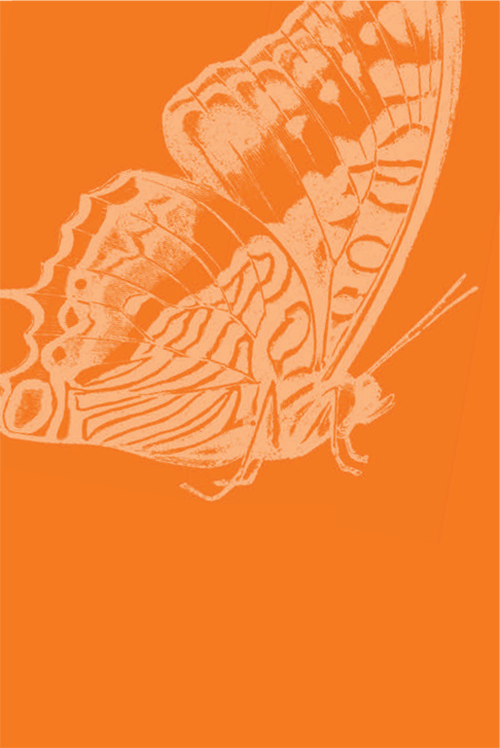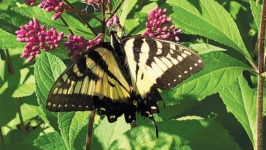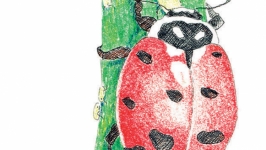Create a Butterfly Habitat in Your Yard this Summer
One of summer’s pleasures is catching a glimpse of a butterfly in your backyard. As beautiful as they are to look at, butterflies are also doing important work: pollinating your landscape plants. Stories of declining Monarch butterfly populations have made the news for the last several years. But they are not the only species in trouble. Invertebrates of all sorts are declining dramatically. There are many reasons for their decline, including pesticide use and habitat fragmentation. In many towns, there may be large natural areas with the right nectar and food sources, but they are no longer connected because of development that has occurred. We can fix that by planting more native plants in our own yards to connect these habitats.
There are about 722 butterfly species in North America. The most common are grouped into six families: Swallowtails, Whites and Yellows, Gossamer-wings, Metalmarks, Brushfoots, and Skippers. Many of them have very specific requirements that you may not be able to replicate in your garden. For instance the beautiful blue Early Hairstreak is endangered here in NJ. It lays its eggs inside the beechnut. Beeches don’t always produce nuts these days because of Beech Bark Disease. But you can attract other species by installing native plants that serve the needs of all the life stages of the butterfly. They need a place to lay eggs, food plants for the caterpillars, a place to form a chrysalis, and a nectar source for the adult butterflies. They also need a shallow source of water. Filling a small bird bath with stones and water is a great option.
Butterflies lay tiny eggs on the leaves of the plant that will later become food for hatchling caterpillars. It’s important for her to lay eggs on the right plant, so her young will have food to eat. Specialist butterflies have co-evolved with certain plant species and cannot survive without their plant pairing. Host plants like Blackeyed Susans, Coneflowers, and Sunflowers attract Checkerspots. Asters draw Pearl Crescents and Painted Ladies. Dill suits Black and Anise Swallowtails. Milkweed is perfect for Monarchs. Violets draw Fritillaries and the supercool Falcate Orangetip. (These white butterflies have bright orange splotches on the outside of their forewings, the largest set of wings. The caterpillar is bright green with long blue, white, and yellow stripes.)
Other butterflies, like Cabbage Whites, are not as fussy, getting nectar from a wide range of plants. These generalist butterflies are attracted to flat-topped flowers like Zinnias or clustered flowers with short tubes like Beardtongue. Plant these in full sun, as butterflies generally only feed in sunshine. Plan for continuous feeding by choosing spring, summer, and fall bloomers.
If you want to see Pipe Vine Swallowtails, you need to plant native Pipe Vines, or Dutchman’s Pipe, named because the flower looks very much like a pipe. While the adults can get nectar from a variety of plants, the young caterpillars feed only on Pipe Vine leaves. These plants can be hard to find locally and you may have to purchase online. Visit Frelinghuysen Arboretum in Morris Township in the summer when their huge Pipe Vine is in bloom and you are sure to see some of these Swallowtails. They are black and iridescent blue with orange and white spots on their underwings.
I love that there is really no correlation between the caterpillar and the butterfly in terms of coloring. Some of the wildest caterpillars transform into rather lackluster butterflies. The orange Monarch’s caterpillar stage is a yellow, black, and white tiger striped, while the Eastern Tiger Swallowtail’s caterpillar is a crazy acid green with a yellow stripe and cartoonish eyes. I once found what turned out to be a Cecropia moth caterpillar on my boot. Acid green with yellow, blue, and orange protrusions, each with black whiskers. Frightening and amazing, it transforms into the largest moth in North America with a five- to seven-inch wingspan, a grey and orange beauty.
Start your butterfly gardening journey with these plants that will thrive in New Jersey and provide haven and food for butterflies as they move through their life cycle. For perennials, I suggest Hoary Mountain Mint, Butterfly Milkweed, Blue Flag Iris, Spotted Geraniums, and Purple Coneflower. Shrubs that butterflies love include Blackhaw Viburnum and Spicebush. And larger trees (yes, butterflies love trees!) include Red Oak, Black Cherry, Juniper, Sassafras, Tulip Tree, and River Birch.
To have a successful butterfly garden, you must also commit to stop using insecticides. You are creating habitat to bring in butterflies, and while you might be spraying to control a different, specific pest, the poison does not discriminate.
Gardening season isn’t the only time to help butterflies. In the fall, try to “leave the leaves.” While Monarchs head south for the winter, most butterflies hunker down as eggs, caterpillars, chrysalises, or adults, rolling themselves up in dried leaves, hiding in plant stems, or disguising themselves as leaves in your garden. Leaving a mess of fallen foliage in your garden beds may seem unsightly, but it will provide cover for butterflies and other beneficial bugs over the winter.
If the idea of an untidy garden does not sit well with you, pick one bed less visible from your window and dedicate it to nature where the “mess” will provide a few ecosystem services. When you leave the full fall cleanup until late spring, you help the bugs that will help you out later. This is just as important as putting in the right perennials.
By creating even a small butterfly habitat in your yard, you are doing important work. It may seem that your one suburban lot could not make a difference, but if you and several of your neighbors plant more native plants, you start connecting the fragmented lands that are critical to butterflies and other pollinators. And you bring more beauty and life into your garden.
Life Cycle of a Butterfly

Photo: JPS/adobestock.com
Caterpillar (larva stage):
The tiny eggs laid on plants by adult butterflies hatch to caterpillars, in the larva stage. Caterpillars eat and eat, and shed their skin several times as they grow and move through several instar phases. Monarchs go through five instars. These caterpillars can grow 100 times in size in a few weeks. This stage is the most dangerous in their life cycle as they become food for predators, especially for birds, which depend on these small soft-bodied guys to feed their young. While the females lay hundreds of eggs, only a few survive to the adult stage.
Cocoon (pupa stage or chrysalis):
Within a few weeks of hatching, caterpillars will create a cocoon. Moths protect the pupa in a cocoon of silk or, for Monarchs, a sort of shell. This takes from weeks to a month or longer. Big changes are going on inside; they are undergoing metamorphosis, growing legs, wings, eyes, and more. They do not eat during this stage.
Butterfly (adult stage):
Finally, a butterfly emerges. The butterfly’s job is to mate and lay eggs. It is no longer growing. Some butterflies get energy from cells of the caterpillar, others from nectar. Some don’t feed at all. This beautiful stage is very short, only one or two weeks. Providing flowers for nectar now will help keep them around to repeat the cycle again.
 For More Information & Inspiration
For More Information & Inspiration
North American Butterfly Association, naba.org
This organization’s website is a treasure trove of how-to’s, facts, activities, and news. You can certify your butterfly garden with them right online and receive a sign to let your neighbors know what’s up. They also have a very active chapter in New Jersey (naba.org/chapters/nabanj/).
Butterfly Gardening: The North American Butterfly Association Guide by Jane Hurwitz (Princeton University Press, 2018)
This nationally lauded book is a visual treat and an indispensable guide to creating a garden that attracts and sustains butterflies. Author Jane Hurwitz is a local NJ butterfly gardener who also blogs on the topic at janehurwitz.com. Book available on her website, via Amazon, or order from your local bookseller.
Local Nurseries:
Local nurseries and farms are often the best place to start looking for native plants (and advice!) to attract butterflies. For more unusual natives, try toadshade.com and wildridgeplants.com.









